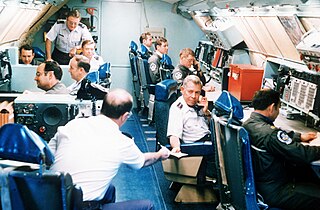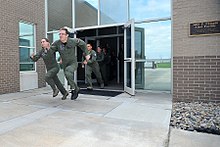
Strategic Air Command (SAC) was a United States Department of Defense Specified Command and a United States Air Force (USAF) Major Command responsible for command and control of the strategic bomber and intercontinental ballistic missile components of the United States military's strategic nuclear forces from 1946 to 1992. SAC was also responsible for the operation of strategic reconnaissance aircraft and airborne command post aircraft as well as most of the USAF's aerial refueling fleet, including aircraft from the Air Force Reserve (AFRES) and Air National Guard (ANG).

The LGM-30 Minuteman is an American land-based intercontinental ballistic missile (ICBM) in service with the Air Force Global Strike Command. As of 2023, the LGM-30G Minuteman III version is the only land-based ICBM in service in the United States and represents the land leg of the U.S. nuclear triad, along with the Trident II submarine-launched ballistic missile (SLBM) and nuclear weapons carried by long-range strategic bombers.

Ellsworth Air Force Base (AFB) is a United States Air Force (USAF) base located about 10 miles (16 km) northeast of Rapid City, South Dakota, just north of the town of Box Elder.

The Boeing E-6 Mercury is an airborne command post and communications relay based on the Boeing 707-300. The original E-6A manufactured by Boeing's defense division entered service with the United States Navy in July 1989, replacing the EC-130Q. This platform, now modified to the E-6B standard, conveys instructions from the National Command Authority to fleet ballistic missile submarines, a mission known as TACAMO.

TACAMO is a United States military system of survivable communications links designed to be used in nuclear warfare to maintain communications between the decision-makers and the triad of strategic nuclear weapon delivery systems. Its primary mission is serving as a signals relay, where it receives orders from a command plane such as Operation Looking Glass, and verifies and retransmits their Emergency Action Messages (EAMs) to US strategic forces. As it is a dedicated communications post, it features the ability to communicate on virtually every radio frequency band from very low frequency (VLF) up through super high frequency (SHF) using a variety of modulations, encryptions and networks, minimizing the likelihood an emergency message will be jammed by an enemy. This airborne communications capability largely replaced the land-based extremely low frequency (ELF) broadcast sites which became vulnerable to nuclear strike.

The Strategic Automated Command and Control System (SACCS) is a United States Strategic Command command and control system to coordinate the operational functions of United States nuclear forces.

A launch control center (LCC), in the United States, is the main control facility for intercontinental ballistic missiles (ICBMs). A launch control center monitors and controls missile launch facilities. From a launch control center, the missile combat crew can monitor the complex, launch the missile, or relax in the living quarters. The LCC is designed to provide maximum protection for the missile combat crew and equipment vital to missile launch. Missile silos are common across the midwestern United States, and over 450 missiles remain in US Air Force (USAF) service.

The 44th Missile Wing is an inactive United States Air Force unit. Its last assignment was with Twentieth Air Force, being assigned to Ellsworth AFB, South Dakota. It was inactivated on 4 July 1994.

The 28th Bomb Wing is a United States Air Force unit assigned to the Eighth Air Force of the Air Force Global Strike Command (AFGSC) and is stationed at Ellsworth Air Force Base, South Dakota. The wing is also the "host unit" at Ellsworth AFB.

The Boeing EC-135 is a retired family of command and control aircraft derived from the Boeing C-135 Stratolifter. During the Cold War, the EC-135 was best known for being modified to perform the Looking Glass mission where one EC-135 was always airborne 24 hours a day to serve as flying command post for the Strategic Air Command in the event of nuclear war. Various other EC-135 aircraft sat on airborne and ground alert throughout the Cold War, with the last EC-135C being retired in 1998. The EC-135N variant served as the tracking aircraft for the Apollo program.

Looking Glass is the historic code name for an airborne command and control center operated by the United States. In more recent years it has been more officially referred to as the ABNCP. It provides command and control of U.S. nuclear forces in the event that ground-based command centers have been destroyed or otherwise rendered inoperable. In such an event, the general officer aboard the Looking Glass serves as the Airborne Emergency Action Officer (AEAO) and by law assumes the authority of the National Command Authority and could command execution of nuclear attacks. The AEAO is supported by a battle staff of approximately 20 people, with another dozen responsible for the operation of the aircraft systems. The name Looking Glass, which is another name for a mirror, was chosen for the Airborne Command Post because the mission operates in parallel with the underground command post at Offutt Air Force Base.

The 625th Strategic Operations Squadron (STOS) is a United States Air Force nuclear missile control & support squadron. The 625th STOS has five flights that play different roles in this mission. The Latin motto of the 625th STOS is Si vis pacem para bellum, which means, "If you wish for peace, prepare for war."

The 4th Special Operations Squadron is part of the 1st Special Operations Wing at Hurlburt Field, Florida. It operates Lockheed AC-130J aircraft providing special operations capabilities.

The 68th Missile Squadron is an inactive United States Air Force unit. It was last assigned to the 44th Operations Group, stationed at Ellsworth AFB, South Dakota.

The Emergency Rocket Communications System (ERCS) was designed to provide a reliable and survivable emergency communications method for the United States National Command Authority, using a UHF repeater placed atop a Blue Scout rocket or Minuteman II intercontinental ballistic missile. ERCS was deactivated as a communication means when President George H.W. Bush issued a message to stand down SIOP-committed bombers and Minuteman IIs on 27 September 1991. Headquarters SAC was given approval by the Joint Chiefs of Staff to deactivate the 494L payloads beginning 1 October 1992. However, Headquarters SAC believed it was inefficient and unnecessary to support ERCS past fiscal year 1991, and kept the accelerated deactivation schedule.

The Post Attack Command and Control System (PACCS) was a network of communication sites for use before, during and after a nuclear attack on the United States. PACCS was designed to ensure that National Command Authority would retain exclusive and complete control over US nuclear weapons. Among other components, it included Strategic Air Command assets such as the Looking Glass aircraft and mission, and various hardened command and control facilities.

The United States Air Force's 2d Airborne Command and Control Squadron was an airborne command and control unit located at Offutt Air Force Base, Nebraska. The squadron was an integral part of the United States' Post Attack Command and Control System, performing the Operation Looking Glass mission with the Boeing EC-135 aircraft.

Airborne Launch Control Centers provide a survivable launch capability for the United States Air Force's LGM-30 Minuteman Intercontinental Ballistic Missile (ICBM) force by utilizing the Airborne Launch Control System (ALCS) on board which is operated by an airborne missileer crew. Historically, from 1967–1998, the ALCC mission was performed by United States Air Force Boeing EC-135 command post aircraft. This included EC-135A, EC-135C, EC-135G, and EC-135L aircraft.
A missile combat crew (MCC), is a team of highly trained specialists, often called missileers, staffing Intermediate Range and Intercontinental ballistic missile systems. In the United States, personnel, officially coded as Nuclear and Missile Operations Officers, of the United States Air Force, operate underground missile systems at launch control centers located throughout the country. There are also a select few missileers that have the chance to become part of a Missile Combat Crew-Airborne (MCC-A) operating the Airborne Launch Control System which provides a survivable launch capability for the Minuteman ICBM force. Crew size varies among the different missile systems, but the number is always greater than one, to abide by USSTRATCOM's two-man rule for positive control of nuclear weapons.

Strategic Communications Wing 1 is a nuclear command and control wing of the United States Navy. Its TACAMO mission provides airborne communications links to nuclear missile units of United States Strategic Command. It is located at Tinker Air Force Base, Oklahoma.

























